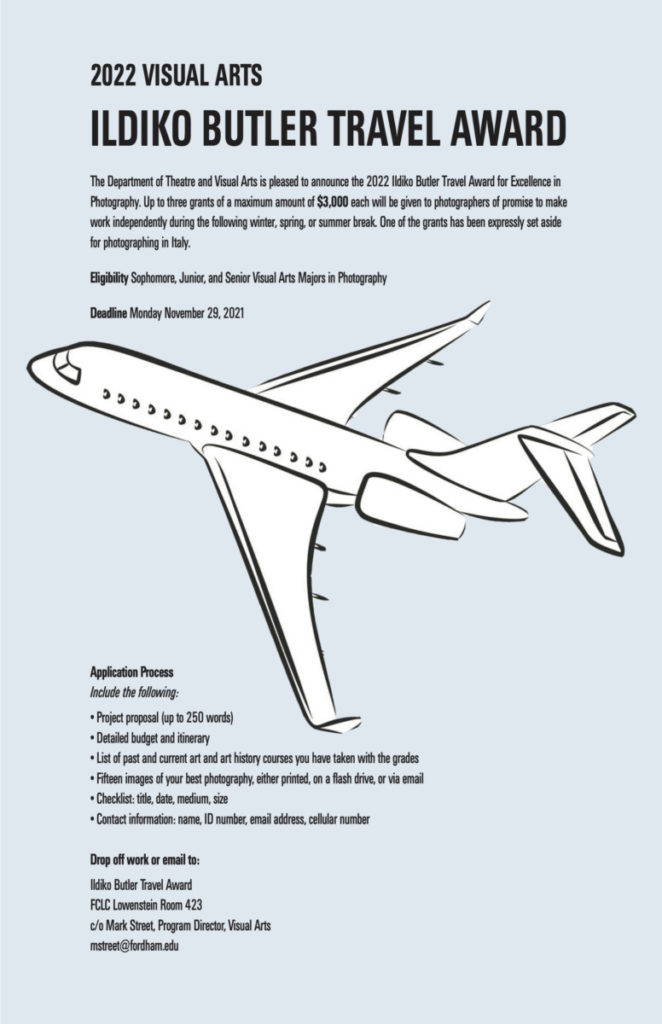Spring Majors Meeting
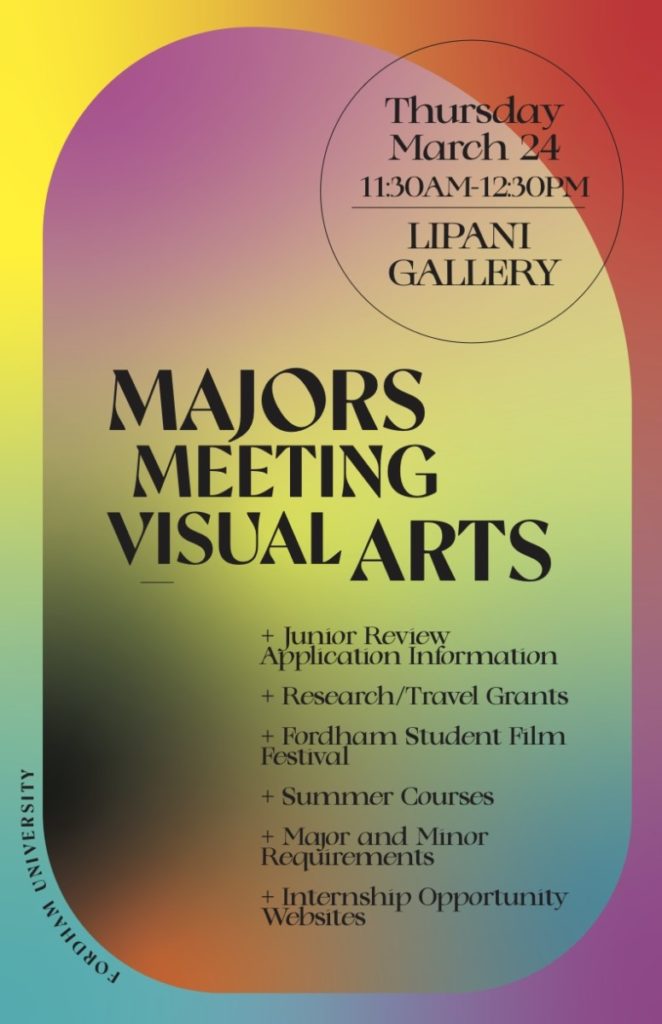

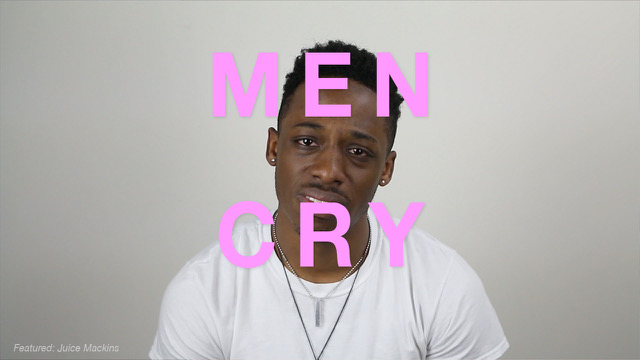
The Fordham University Galleries
Fordham University at Lincoln Center map
113 West 60th Street at Columbus Avenue
New York, NY 10023
fordhamuniversitygalleries
March 1 – March 20, 2022
The Visual Arts Program at Fordham University is pleased to present MEN CRY, a video series by Fordham alumnus Martin Nuñez-Bonilla (’18). This moving compilation of interviews began with the seemingly simple question: When was the last time you cried?
In the words of the artist:
Four years ago, when I was a senior at Fordham, I spent a month talking to men about their feelings in the studio of the Visual Arts Complex at the school. Those interviews would go on to become MEN CRY, a video series in which people talk about their feelings and experiences with masculinity. What started out as a response to sexism and the violence that comes from emotional repression in men has turned into so much more. The project has reached across the country and continues to build community with people who want to encourage authenticity in a suppressive world. Masculinity is a topic that is so much more nuanced and wide-reaching than I could have ever imagined. This nuance has created the current moment, in which MEN CRY has evolved and I’m trying to figure out what comes next.
Today, four years later, I’ve turned 25, experienced a pandemic, left a 9 to 5 job, and been formally diagnosed with clinical depression and anxiety. This big moment in my life has inspired me to take a step back and examine my own habits, mental health, and masculine behaviors. It’s not enough to say the right things and be a “good guy” — I have to also challenge myself to improve.
I am in transition and the MEN CRY project is in transition, too. As I take this time to grow and explore, I also want to take the time to look back and appreciate the folks who have shared incredible stories and demonstrated such tenderness and love. I’d like to give a special thank you to everyone who was brave enough to cry, to laugh, and to feel on MEN CRY.
JP Alba-Dennis
Dominick Alcantara
Jordan Almodovar
Daniél Alvarez
Miles Ballard
Arthur Banach
Mik Berry
Jason Bost
Isabella Breton
Michael Cole
Jose “Mozo” Cruz
Chandler Dean
Jack DeWahl
Sergio Echenique
Kelveen Fabian
Maribí Henriquez
Doug Horner
Amilcar Javier
Kyle Kilkenny
Lou Knows
“Juice” Mackins
Luis Mejicanos
Tony Quera
T Michael Rock
José Roldan Jr.
Dorien Russell
Vincent Rutherford
Ian Schafer
Given how much love we’ve all put into this project, I hope you can walk away knowing:
Martin Nuñez-Bonilla is an Afro-Latino visual artist and public speaker based in New York City with a passion for masculinity reform, BIPOC equality, and vulnerability. He currently works with organizations, causes, and events on their visual materials and communications. He can be reached at martinnunezbonilla.nyc@gmail.com or via his website (www.mnbnyc.com) or Instagram (@mnbnyc).
MEN CRY is an unscripted video series and digital platform for exploring modern masculinity, sharing stories, and sharing resources for people of all genders. You can watch past episodes on YouTube, check out the Instagram Live series on @allmencry, or learn more at mencry.nyc.
If you are a student struggling with your mental or emotional health, or if you just need someone to talk to about the challenges you are facing, Fordham’s Counseling and Psychological Services (CPS) offers free and confidential services on both campuses. To schedule an initial screening or walk-in appointment, please call or visit one of their offices (at Lincoln Center: 160 W 62nd Street, rm G-02, 212-636-6225; at Rose Hill/Westchester: O’Hare Hall Basement, 718-817-3725). If you are experiencing a mental health emergency during non-business hours, please contact the Public Safety Office at Fordham or the National Suicide Prevention Lifeline at 1-800-273-TALK. A representative from the CPS office will also be available outside the gallery from noon to 1pm on March 1, 3, 7, and 11 to answer any questions you may have.
Link to the exhibition
mencry.nyc
Martin Nuñez-Bonilla can be contacted here.
For the Visual Arts Department Blog: click here.
For the Visual Arts Department Website: click here.
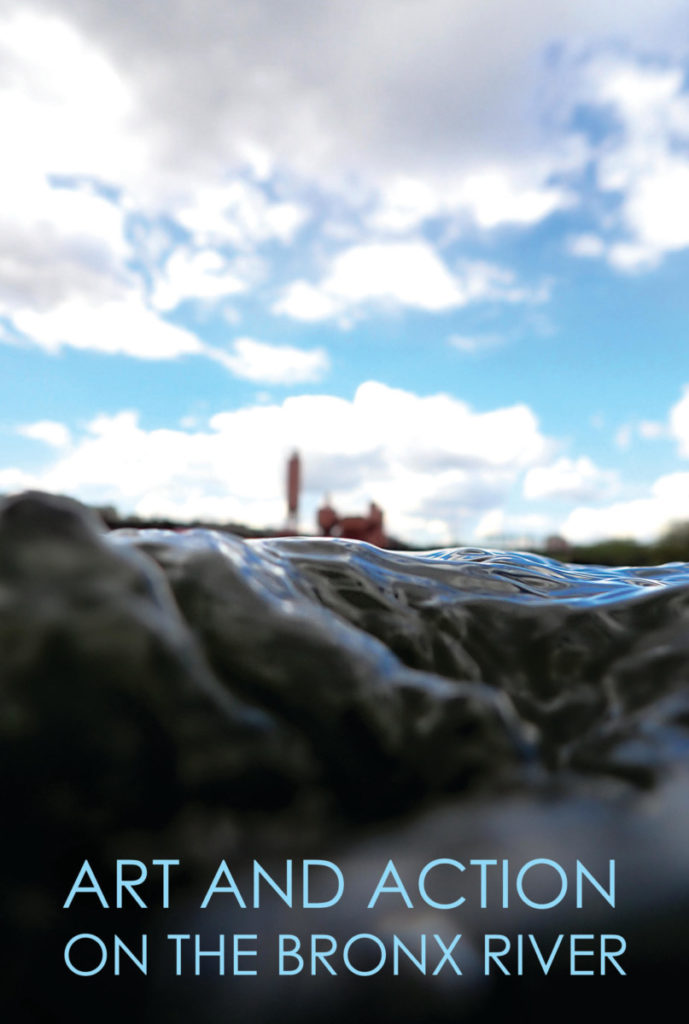
The Fordham University Galleries
Fordham University at Lincoln Center map
113 West 60th Street at Columbus Avenue
New York, NY 10023
fordhamuniversitygalleries
February 14 – March 29, 2022
The Visual Arts Program at Fordham University is proud to present Experiments with Art and Action, a selection of student artwork from Matthew López-Jensen’s course Art + Action on the Bronx River. First offered in spring 2021, this course is designed around direct experiences with the Bronx River, which flows only a few minute’s walk from the Rose Hill campus. The river is a critical urban landmark, a scenic dividing line that runs from Westchester County to the East River. Throughout the semester, students study the history of the river, its ecology, its relationship to surrounding communities, and its connection to New York City’s watershed. Walking, collecting, observation, and boating are used to direct students’ creative output, as can be seen in the works on view. The course also directly engages with the Bronx River Alliance, a nonprofit dedicated to promoting and protecting the river, and many of the pieces in this exhibition will be donated to the Bronx River Alliance for use as educational tools.
Some of the works included are the product of collective action, like a bottle cap cleanup in Starlight Park. The 3000 caps were collected, cleaned, and transformed into a snaking sculptural object and percussion instruments. Other projects include handmade plant identification cards, site-specific maps of landscapes along the Bronx River, landscape and underwater photography, and documentation from performative actions. Each project is the result of students directly engaging with the Bronx River and the adjacent landscapes. The show includes contributions from Lily Ashendorf, Josephine Cohen, Liza Cohen, Grace Dailey, Lina Diamante, Baily Dolgon, Liz Galeano, Nora Hogan, Maggie Hunt, Mack Hurstell, Helen Hylton, Alexandra Klapak, Hanwen (Lina) Li, Zoey Liu, Nicolette Makris, Amelia Medved, Angela Payne, Alexia Ramos, Julia Reynolds, Tayler Rogers, Rosa Schembari, Emily Yankee, Gregory Yared, and Sophia Zehler.
Image: Zoey Liu. Untitled (Concrete Plant Park on the Horizon). 2021.
Experiments with Art and Action Website
For further information, please contact Matthew López-Jensen.
For the Visual Arts Department Website: click here.

The Fordham University Galleries
Fordham University at Lincoln Center map
113 West 60th Street at Columbus Avenue
New York, NY 10023
fordhamuniversitygalleries
The Fordham University Department of Visual Arts Hayden Hartnett Project Space is pleased to present the fourth installment of our Online Portfolio Series with a selection of meticulously drawn and absurdly dense architectural maps by the Spanish/Libyan/Lebanese artist Tarek Abbar. Living in rural Japan certainly affected this globetrotter’s psyche, and you will certainly enjoy this project if you are comfortable with horror vacui (the fear of empty space).
These works of ink on paper are all highly detailed maps of Japan created between 2015 and 2019 in an old house on a remote peninsula in northwestern Japan. Surrounded by cedar, maple, and pine, the studio’s only neighbor is a lonely Shinto shrine, and these drawings of urban concrete stand in stark contrast to the surrounding landscape.
Drawings of buildings create cartography, enclosed by the metallic clouds of industry and watched over by robotic gods. The buildings look Soviet but are the Japanese post-war quick fix structures that repeat across the archipelago like a mantra.
There are two semi-concessions to nature in these works: Mount Fuji in spirit form and the inclusion of water, which in Japan is rarely found in its wild state, instead typically entrapped by concrete.
Tarek Abbar Website
For further information contact Stephan Apicella-Hitchcock.
For the Visual Arts Department Blog: click here.
For the Visual Arts Department Website: click here.
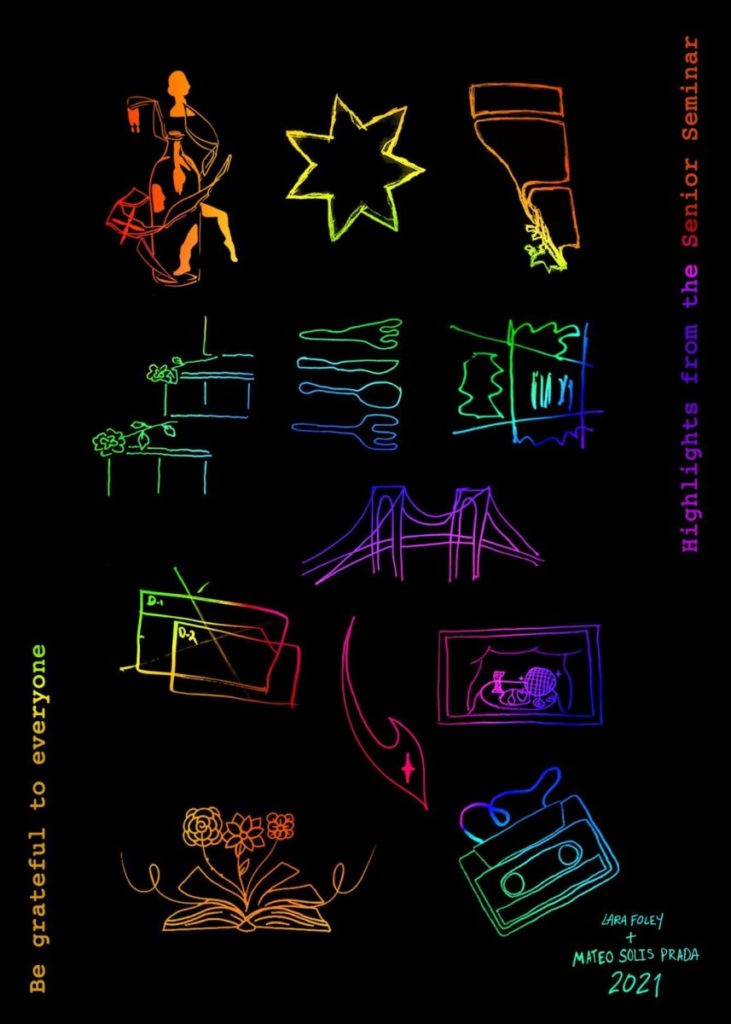
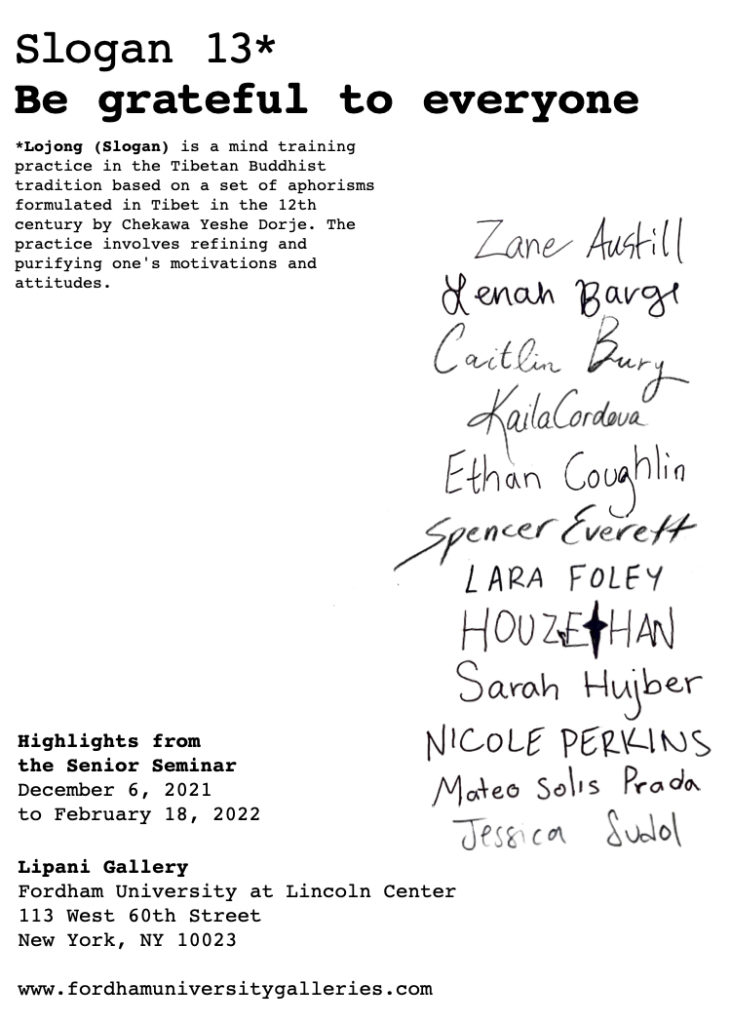
This year’s Senior Seminar exhibition includes work from 12 Visual Arts majors who have worked to present an integrated exhibition, one that celebrates both individual direction and collaboration while inevitably responding to this moment of profound change. As the exhibition’s title suggests, students found ways to make space for new paradigms while engaging in an ongoing conversation revolving around themes of fragility, resilience, memory, transformation, silence, and song. Their work celebrates beauty, personal exploration, historical and political engagement, and empathy, as well as a connection to the sensorial pleasures of materiality, movement, and community.
Zane Austill’s work explores his decision to take a sustained vow of silence. The notes displayed in his installation provide insight into the nature of his conversations since taking the vow, moments both mundane and profound. His film traces the process as he works to understand how an individual need for silence conflicts or is accommodated both inwardly and by those around him.
Lenah Barge looks back to the form of Civil Rights era protest imagery to underscore the long, ongoing struggle for equity in our society. She infuses the form with images from her personal history and asks that we consider engagement, and work towards change.
Caitlin Bury’s installation is inspired by her aunt’s experience as a vocalist in a 1960’s group named The Shannons. Bury finds inspiration and strength in her aunt’s story as she pursues her own creative life, and her project looks at common threads running through their stories as a way of creating histories.
Kaila Cordova creates digital portraits which address the positive and negative emotions that people have experienced during quarantine due to COVID-19. Each image is named after a famous Victorian author and botanical collectives, structures, and arrangements, and relies on the symbolism of Florology to code the images with clues the sitter’s state of mind.
Ethan Coughlin’s My City, Your City is about exploration and the joy of finding unexpected beauty all around you. Coughlin explores New York City and finds wonder in the often unappreciated, hidden places he stumbles upon, such as a colony of Argentine parrots living in the heart of Brooklyn. His installation prompts us to invest attention in the places we call home.
Spencer Everett’s sculptural collages of paper and glass explore the liminal space that exists between the two-dimensional and three-dimensional world. His work addresses the impossible inconsistencies between tangible truth and a “bodiless imposition” experienced in the modern world.
Lara Foley presents painted images on paper and wood that are small in scale and meticulously detailed through layers of pale washes. Foley is interested in the way our subconscious holds onto unanticipated, often peripheral aspects of life, turning small afterthoughts into the moments that continue to carry significance in our lives.
Houze Han makes paintings that convey a deeper, narrative world beyond the canvas, using symbolic shape as language. The composition of each form, the edge, texture, and color, emphasizes the significance of logical, analytical choices made, which in combination transcend their particular forms to tell a story hidden deep inside the artist’s mind.
In her photographic series, Domestic, Nicole Perkins engages the constructs of the interior and the still life to create lush, tightly focused images that ask the question: how do we create a home for ourselves? What does it feel like to be home?
Mateo Solis Prada celebrates the communal experience of sharing a meal via sculpture, sound, and text. His work viscerally conveys the joy of continuity and connection. He sculpts foods that are family heritage, symbols of love and creativity passed down from generation to generation, and the color and care with which he sets his table invites participation in his celebration.
Sarah Hujber photographed the landscape of the American West, spending afternoons in ghost towns where nature was eagerly reclaiming the land lost to human-made structures. Hujber raises questions about lives abandoned, the American Dream, and power of nature in a series of black and white photographs.
In her painting, Not Finished, Jessica Sudol addresses the anxiety that results from the constant demands on one’s time through a slow, methodical meshing of painting and digital structure.
Highlights from the Senior Seminar Website
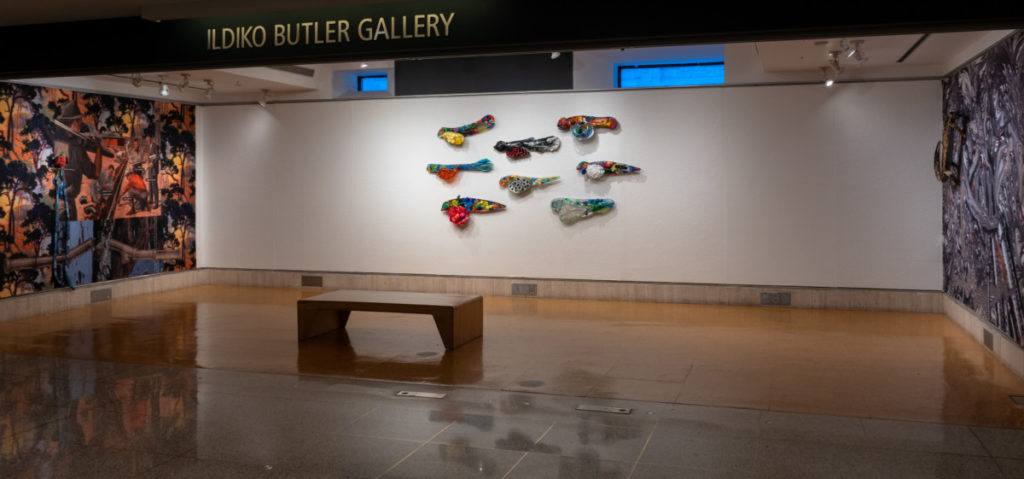
The Department of Visual Arts at Fordham University is pleased to present, Leaf Litter, a new exhibition by Christy Rupp in the Ildiko Butler Gallery.
For the exhibition, Rupp is enlarging images of two cut-paper collages to the full scale of the gallery’s east and west walls and adding wall-mounted sculptures on top of the images. On the east wall is an image of a forest under assault by the construction of pipes and bulldozers, mounted on top is a sculpture of life-size Quetzal (an extinct bird from Guatemala ) made with credit cards, an illusion to borrowing from the future and the connection to extinction. On the west wall is an enlarged collage of burst pipes spewing oil underwater as small planktonic Crabs are carried by the currents directly into the oil spill. On top of this image, there is a Forest Newt, made of charred matches, which links air and water pollution, both destabilized by the effects of excess CO2. The south wall is a series of Aquatic Larvae composed of single-use plastic debris, made by the artist to visualize the integration of microplastic particles into the birth cycles of all living species.
Artist Bio: Christy Rupp is an American eco-artist and citizen scientist. Having grown up in the Rust Belt of upstate NY, she witnessed firsthand the hazards of industrial waste and efforts to conceal the underlying causes of pollution. She moved to NYC in the late ’70s as it faced bankruptcy and offered fertile ground for a generation of artists lucky enough to participate in the petri dish of history, culture, and nature that was late-capitalist downtown. Originating from an interest in urban ecology and the waste stream, Rupp’s work taps into universal themes of climate change and justice. Her work has focused on environmental hazards like fracking waste, oil extraction, and water quality.
Rupp has received grants from the National Endowment for the Arts, New York State Council on the Arts, Anonymous Was A Woman Foundation, Joan Mitchell Foundation (Creating a Living Legacy Award), and Art Matters Foundation. Her work has been visible in the US and internationally since 1979. She lives in New York.
New book: by Christy Rupp. Leaf Litter also celebrates the launch of Noisy Autumn, a monograph of the ecological artworks of Christy Rupp over the past 45 years. It was designed with collaborator Abby Goldstein, Fordham Professor of Art and head of the Graphic Design area. Ms. Goldstein’s book credits are many with best-sellers about type history, and she has also produced numerous catalogs for artists and galleries and is a painter known for her organic imagery. The book is published by Insight Editions on wood-free paper.
Book event on Saturday, December 4, 2–4 pm at Printed Matter/ St. Mark’s.
Image caption: Aquatic Larvae, 2020 welded steel, and single-use plastic debris. Each approximately 33X13X8″
For Christy Rupp’s website, click here.
For further information on the exhibition, contact Abby Goldstein.
For the Visual Arts Department Website: click here.
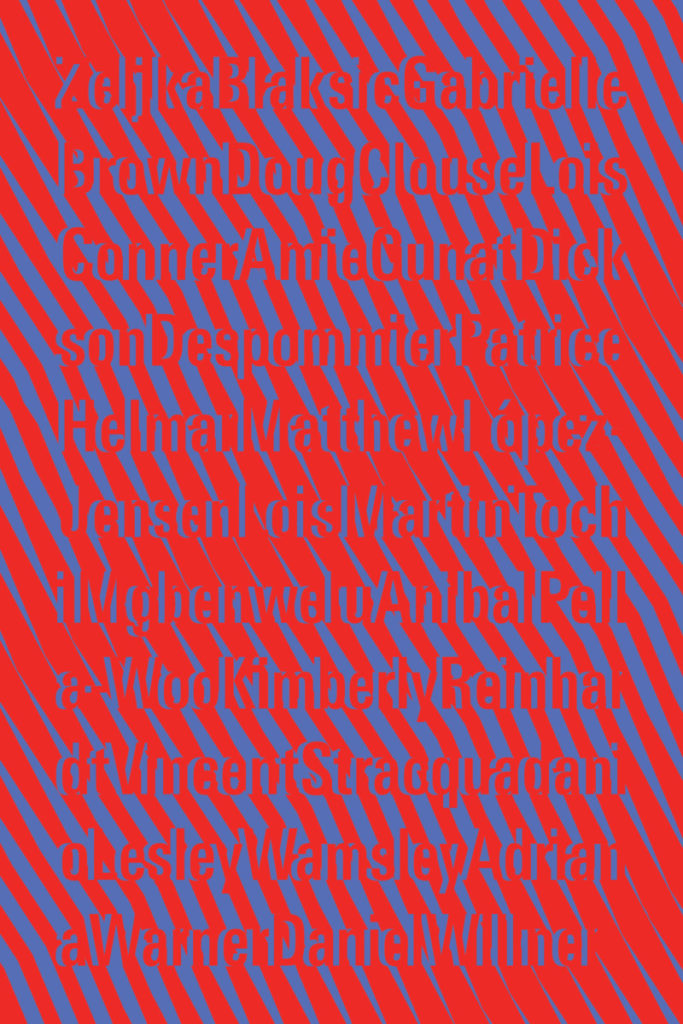
The Fordham University Department of Visual Arts is pleased to announce the release of the 2021 Adjunct Faculty Spotlight catalog on our gallery imprint, Hayden’s Books.
The Department of Visual Arts is fortunate to have so many exceptionally talented Adjunct Professors teaching our students; in fact, we have so many skilled Adjuncts that we had to divide the Spotlight exhibition into two parts during the fall semester. Now, both exhibition installments have been brought together in a single 156-page volume providing a sampling of projects and texts representing each artist/professor.
In both their individual practice and collectively, one can discern a rigorous investigation into visual communication strategies, a spectrum of subjects, and a diverse range of representational methods. Further, this catalog provides an accurate snapshot of the Visual Arts Department, highlighting the breadth of disciplines offered, including film, graphic design, painting, and photography.
The 2021 Adjunct Faculty Spotlight catalog makes manifestly clear that our professors are vital artists as well as outstanding educators in the classroom. The catalog features the following artists: Željka Blakšic, Gabe Brown, Doug Clouse, Lois Conner, Amie Cunat, Dickson Despommier, Patrice Helmar, Matthew López-Jensen, Lois Martin, Anibal Pella- Woo, Kimberly Reinhardt, Vincent Stracquadanio, tochihannah, Lesley Wamsley, Adriana Warner, and Dan Willner.
Organized by Stephan Apicella-Hitchcock
Installation: Wilson Duggan
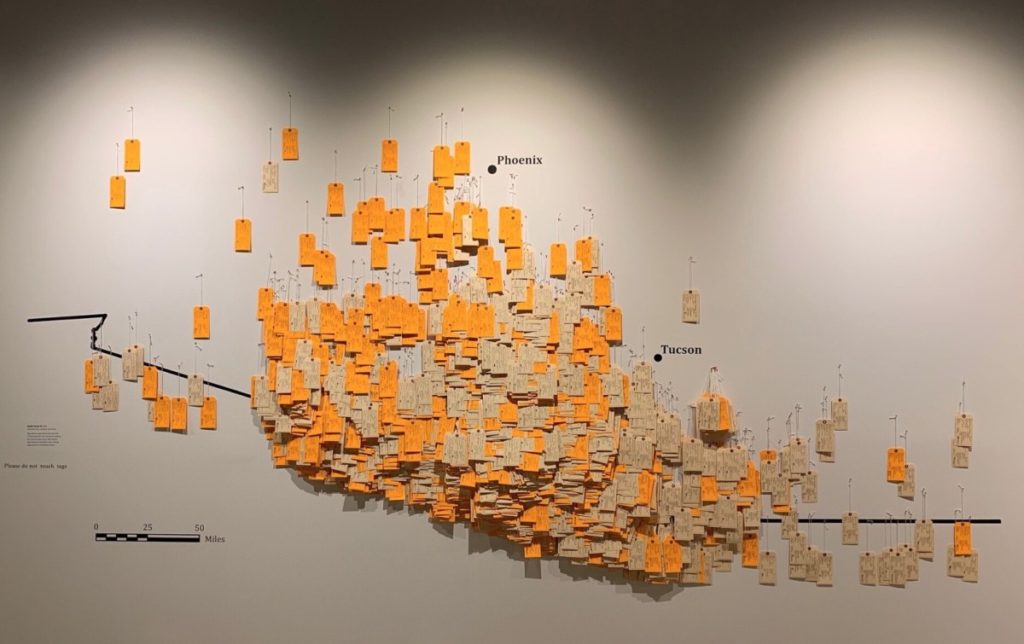
November 4—November 29, 2021
The Fordham University Lipani Gallery
Fordham University at Lincoln Center map
113 West 60th Street at Columbus Avenue
New York, NY 10023
fordhamuniversitygalleries
The Department of Visual Arts and the Department of Modern Languages and Literatures at Fordham University are pleased to present a new exhibition, Hostile Terrain 94, in our Lipani Gallery. Organized at Fordham by Professor Carey Kasten and Professor Stephan Apicella-Hitchcock in collaboration with the Undocumented Migration Project (UMP), Hostile Terrain 94 (HT94) is a participatory art exhibition occurring in nearly 150 cities around the globe that seeks to memorialize and bear witness to the humanitarian crisis at the U.S./Mexico Border that has claimed the lives of thousands of people since the 1990s. This tragic loss of human life is the direct result of U.S. border policies that purposefully put migrants in harm’s way. HT94 raises awareness about the human consequences of these policies while also promoting a global discourse on migration through collaboration with hosting partners and exhibition attendees worldwide.
HT94 is organized by the Undocumented Migration Project (UMP), a 501(C)(3) nonprofit arts-education-research collective aiming to humanize the migrant experience between Latin America and the United States. UMP projects are collaborative public endeavors meant to inspire and engage participants to work towards positive social change.
Image credit: Hostile Terrain 94 photo by UMP
For further information please contact Professor Carey Kasten.
For the Undocumented Migration Project (UMP) Website: click here.
For the Visual Arts Department Website: click here.
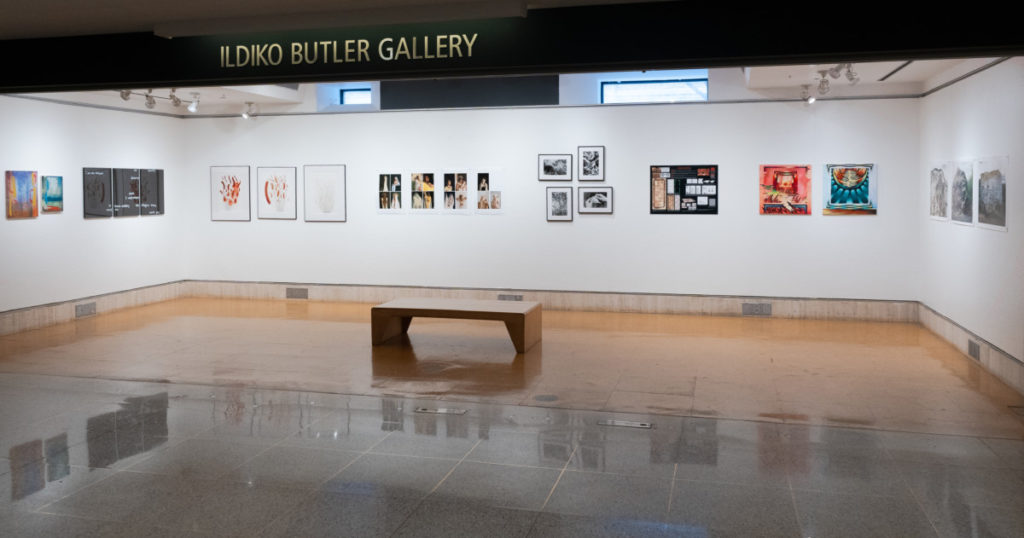
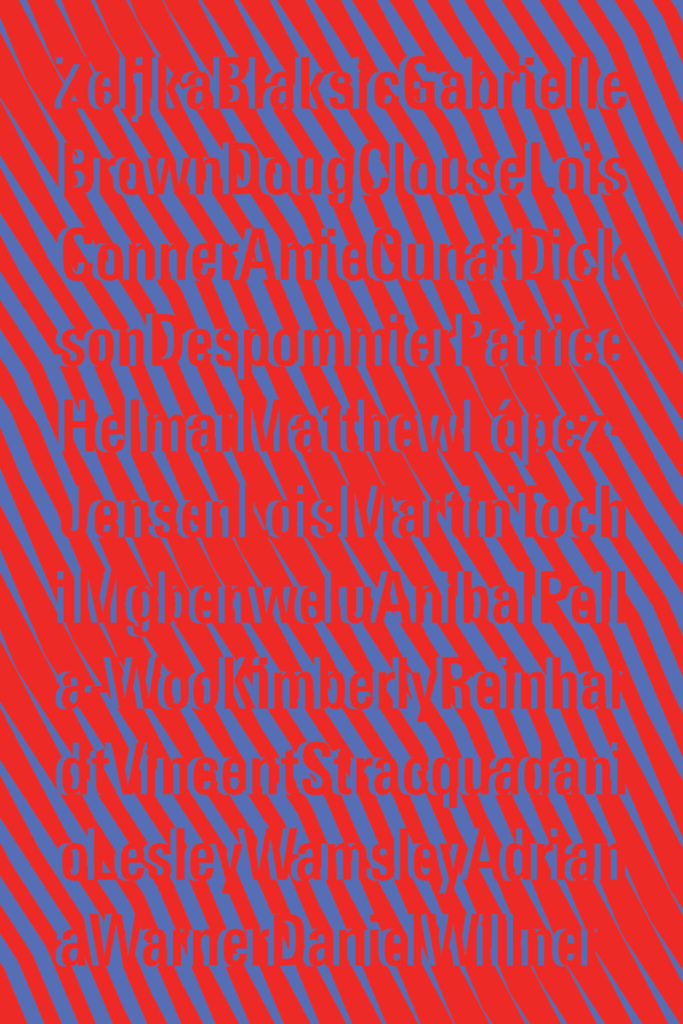
The Department of Visual Arts at Fordham University is pleased to present the 2021 Adjunct Faculty Spotlight exhibition in the Ildiko Butler Gallery. We are fortunate to have so many exceptionally talented Adjunct Professors teaching in our department, in fact, so many that we have had to divide this exhibition into two parts.
The second installment, Adjunct Faculty Spotlight Part Two, will include a sampling of work from the following artists:
Gabe Brown, Lois Conner, Dickson Despommier, Lois Martin, Tochi Mgbenwelu, Vincent Stracquadanio, Adriana Warner, and Dan Willner
This group of artists represents a range of disciplines offered in the Visual Arts Department, including graphic design, painting, and photography. Despite the differences in their mediums, approaches, and subjects, their works are sure to generate lively dialogue.
The artists:
Gabe Brown: I seek a better understanding of truth in nature with constant comparison and evaluation of opposites. Using a visual vocabulary derived from a world that often goes unnoticed and sometimes hidden, everyday events such as conversations between birds, forces that drive water, or the cellular structure of plant life, I begin to reinvent reality. The paintings create a secret recipe for an inner landscape of the human condition; narrative vignettes that are both alluring and mysterious. Nature, and those elements existing in its microcosm become metaphors for a strange and at times super-reality, a parallel universe that questions the natural scheme of life itself.
Lois Conner: My interest in collecting rocks and stones began early. It was a way to preserve my memories, and to take part of the landscape home. As a graduate student, I learned that Chinese scholar rocks were representations of the vastness of nature that painter-scholars took back to the studio to celebrate the landscape, marvel at the universe, and inspire their own creations, both in art and in writing. Without knowing their history, this collection of large boulders in Colorado seemed whimsical, a strange wonder. When I went to photograph, the weather was uncooperatively stormy, and later, so severe that it caused mudslides and closed the nearby Independence Pass. I was momentarily held captive in this little world, mining this “world within worlds” with great abandon.
Dickson Despommier: I am a painter/photographer who spent 12 years at the Art Students League in New York studying with Mario Cooper and Dale Meyers. I am a member of the Salmagundi Club in NYC. These are representative of some of my recent watercolor paintings that I entitle Germination. I live in Fort Lee, New Jersey with my wife, Marlene Bloom, an accomplished artist who paints in oil on canvas.
Lois Martin: Throughout my working life, archaeological illustration has been a constant part of my art practice. Museums and scholars commission some pieces, to accompany exhibitions or publications; I produce others to complement my own research. I focus primarily on the arts of the ancient Americas and have a particular interest and expertise in pre-Columbian (before Columbus, pre-1492) textiles. Many of the illustrations are line drawings that can help clarify complex imagery. For instance, in 1991, I completed a full set of pen-and-ink drawings of a 2,000-year-old textile masterpiece from the South Coast of Peru for the Brooklyn Museum of Art. The Museum published drawings and my text in a brochure and continues to print them as gallery panels to help orient visitors.
Tochi Mgbenwelu: Tochi, like you, is a person navigating the world who just happens to be sharing her experiences through various means of documentation. This series, The Reigning Conglomerate, came about as a result of trying to personally answer the question, “Is God a Black Woman?”
Vincent Stracquadanio: The spaces in my work depict moments of transformation and magic. The rich patterning of these spaces is dense with visual surprise and reference. Some spaces are filled with foreboding forms such as dark fire and cloud-like mists that appear to seep through various Sicilian porticos disrupting spatial certainty. Others, archetypical forms like the “Arch” and the “Portal” line technicolor corridors that peer out into a horrific black abyss from a Giallo film. In these spaces, I’ve mined my own relationship to histories of art, family, and self. These lavish interior spaces collapse and extend using patterning and flatness that eliminates hierarchies between foreground and background, form and formlessness, clarity and confusion.
Adriana Warner: With a keen interest in letterforms and language, I use my work to articulate the realities of my existence as a Black American living in a country and under a system that continues to thrive on the oppression of non-white, particularly Black and Indigenous people. “Systems of oppression are durable and reinvent themselves” and so, I find it appropriate to call out and challenge these systems, giving special attention to harmful hypocrisies and the deadly consequences of such. In this piece, Untitled triptych, I explore ideas around clarity and accessibility as it relates to messaging about history and propaganda. Pulling from Frederick Douglass’ 1852 speech ‘What, to the slave, is the Fourth of July’, this work is a direct response to the 2020 uprising following the murders of George Floyd, Breonna Taylor, and many others.
Dan Willner: My photographs reflect a lifelong fascination with the natural world, with how we find nature and how we change it. An excerpt from an accompanying text to the photographs, Shelving Rock: There’s no wrong way to the summit — Shelving Rock is so small other mountains sidle up to look good by comparison — I’ve been coming here for years alone, married, a father — wondering always if mountains are fountains for men — why do I get to the top and still feel like I’m climbing?
For further information contact Stephan Apicella-Hitchcock.
For the Visual Arts Department Website: click here.
